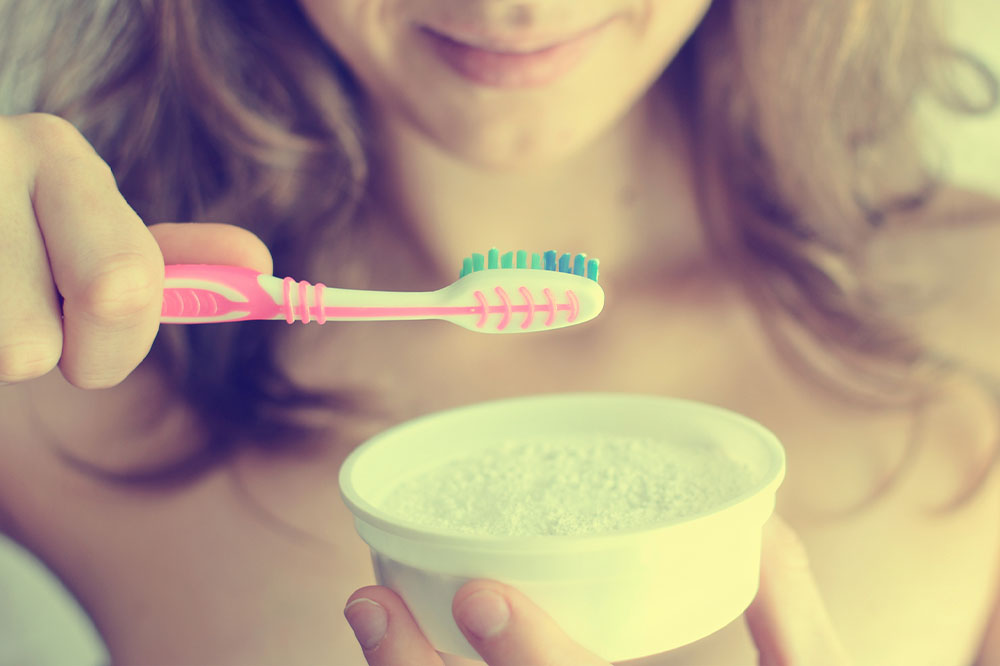White teeth can be a confidence booster and enhance one’s smile. But the teeth may lose their shine and become dull due to aging, plaque accumulation, acidic food intake, and poor hygiene. Besides, gum diseases and genetics also play a role. Therefore, many treatments claim to whiten teeth, but natural remedies are safer and help maintain optimal oral health in the long run. Below are some effective natural remedies that can help whiten one’s teeth.
What causes teeth to discolor?
The outermost covering of one’s teeth, called enamel, serves as a protective white layer for the deeper tooth structures. When the enamel wears off, the yellow-brown bone tissues underneath it, called dentin, begin to show. Enamel eroding can lead to discoloration, tooth sensitivity, and cavities.
Ways to protect enamel and white teeth naturally
Brush twice a day
Toothbrushing is a simple and common oral hygiene task that ensures the longevity of one’s teeth and their whitening. Doctors recommend brushing twice daily for a couple of minutes in a circular motion into all the cracks and crevices. It’s important to brush gently so one does not affect the enamel or accidentally hurt the gums. One is advised not to brush immediately after consuming acidic foods and drinks since the acids can brush away the enamel. On the other hand, one can brush simply with water after having foods that stain.
A recent study showed that whitening toothpaste while brushing can also help brighten one’s smile. The mild abrasives added to the whitening toothpaste gently clean the teeth off surface stains and are safe to use. One can also opt for an electric toothbrush to remove the surface stain.
Thoroughly chew high-fiber foods
The acid in one’s mouth can adversely affect one’s enamel. One way to neutralize the acid is to eat fiber-rich foods like beans, leafy greens, and other vegetables that trigger the mouth to produce more saliva. This natural saliva can wash away the acid and keep one’s teeth white.
Brush with baking soda
Baking soda is traditionally believed to have natural and mild teeth-whitening properties. So it is also a common natural ingredient found in teeth-whitening toothpaste. Baking soda creates an alkaline environment in one’s mouth, which prevents bacteria from growing. Studies show that toothpaste containing baking soda effectively reduces plaque, soothes gum inflammation, and gives a whitening glow to one’s teeth. One can mix a teaspoon of baking soda with twice as much water and use the paste for brushing a couple of times every week. While these remedies are safe, and some have traditionally been used for centuries, it’s still advisable to check one’s oral health with a healthcare professional and get a customized plan of action for optimal oral health.
Practice oil pulling
Oil pulling is a type of remedy traditionally used to improve one’s oral hygiene, whiten one’s teeth, and remove toxins from one’s body. This age-old technique commonly uses cold-pressed organic coconut, sesame, or sunflower oil. Coconut oil is exceptionally high in lauric acid, which is known for reducing inflammation and killing bacteria. One can swish a tablespoon of organic oil in one’s mouth for a few minutes to remove bacteria, which turns into plaque later. Avoid swallowing or letting the oil touch the throat as it contains toxins from one’s mouth. This method does not expose one’s teeth to acid or other ingredients that erode the enamel.
Use hydrogen peroxide
Hydrogen peroxide, a natural bleaching agent, kills bacteria in one’s mouth. Many commercial whitening kinds of toothpaste use high concentrations of hydrogen peroxide that have proven to reduce discoloration caused by coffee and whiten teeth in about twelve weeks. If one intends to experiment, one can use diluted hydrogen peroxide at home by mixing the solution with an equal amount of water as a mouthwash before brushing teeth. One can mix it with baking soda with a 2:1 ratio to create a paste and gently brush it once or twice a week. It’s advisable to consult one’s dentist to ensure the remedy aligns with one’s ongoing oral treatment or teeth condition.
Use activated charcoal
Activated charcoal is highly absorbent and is known to remove stains and pigments from one’s teeth. Moreover, it can also get rid of bacteria and toxins in one’s mouth. One can gently brush or dab the activated charcoal on one’s teeth and leave it on for a couple of minutes. One can also opt to dilute it with water and use it as a mouthwash. It’s advisable to rinse one’s mouth thoroughly later to avoid any residue. Studies show that activated charcoal can whiten teeth within a month. But it can be abrasive on teeth and affect one’s enamel if used extensively or aggressively.
Use apple cider vinegar
Apple cider vinegar has a bleaching effect on one’s teeth. One can use it as a mouthwash by diluting it with three times as much water as vinegar. However, using it with caution is advisable since using an excessive quantity of apple cider vinegar frequently can damage one’s teeth enamel.
Eat fruits
Chewing on raw fruits with high water content can produce saliva and help one to get rid of plaque and acids. Studies also state that vitamin C in citrus fruits helps remove plaque that causes teeth to turn yellow. Rubbing orange, banana, or lemon on one’s teeth may also help to whiten them. Another study also showed that papain enzyme found in papaya and bromelain found in pineapple help remove teeth stains. Similarly, strawberries can help exfoliate one’s teeth and make them appear whiter.
Avoid sugar and staining foods and beverages
Apart from the remedies, one can also incorporate suitable eating habits to ensure one’s teeth are not damaged or stained. Sugary foods boost the growth of bacteria that causes plaque and gingivitis. Alternatively, soda, red wine, coffee, and dark berries are known to stain teeth. So having them in moderation and brushing one’s teeth immediately after eating them can maintain the shine.



